Jackson Mark. Machining with Abrasives
Подождите немного. Документ загружается.

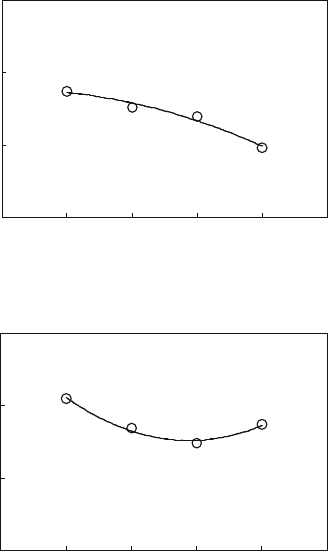
Fig. 8.11 that the surface finish is improved when the number of vanes machined
by an abrasive belt is increased or the belt is getting duller. When the sharp edges
of abrasives disappears, the depth of cut is decreased, leading to a lower value of R
a
.
The belt wear was also examined using scanning electron microscope
(Philips 430). Figure 8.12 shows the topographies of the abrasive belt that has
polished one to four pieces. The wear of the abrasive grain was developed after
machined one vane (Fig. 8.12a) and increased with the further polishing.
After machined three vanes the plateau was built up. Grain pulling-off was
observed on the belt after polishing of four workpieces. This corresponds to the
drop of the material removal in Fig. 8.10 as a result of losing some effective cutting
grains. At the same time, excessive heat may be generated. The belt should be
replaced at this situation.
To save the machining cost and machine down-time, an abrasive belt should be
used to polish workpieces as more as possible, but this is compromised by the
requirement of a constant removal rate. In other words, a constant material removal
rate has to be maintained during the course of polishi ng. As a consequence, the belt
wear must be compensated. The compensation can be made by varying abrasive
0
10
20
30
Removal Amount (grams)
Number of Parts Machined
012345
Fig. 8.10 Effect of number
of vanes machined an
abrasive belt on removal
amount per pass. Belt
speed ¼12.6 m/s, feed
rate ¼1.2 m/min,
preload ¼19 kg
0
1
2
3
012345
Roughness, R
a
(µm)
Number of Parts Machined
Fig. 8.11 Effect of number
of vanes machined an
abrasive belt on roughness.
Belt speed ¼12.6 m/s, feed
rate ¼1.2 m/min,
preload ¼19 kg
8 Polishing Using Flexible Abrasive Tools and Loose Abrasives 355
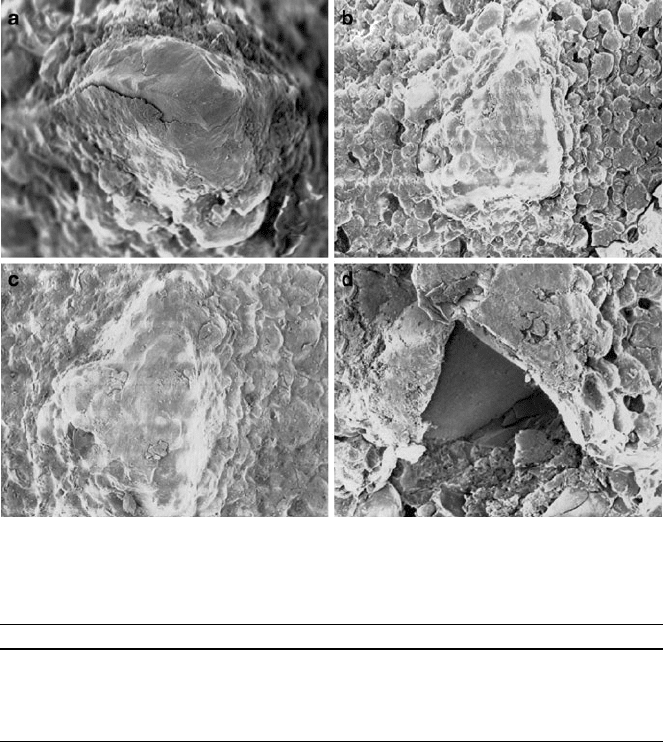
belt speed and feed rate, according to the results shown in Figs. 8.7 and 8.8, as these
two parameters can be adjusted in the robot programing. Pre-load can not be
adjusted because its change is manually manipulated. Table 8.3 summarises the
optimal belt speed and feed rate used for compensating tool wear in the polishing of
backing strips and vane airfoils. The belt speed is increased and the feed rate is
decreased to compensate the belt wear, aiming at maintaining a const ant removal
rate. It should be noted that to meet the surface finish requirement, a fine polishing
process is arranged after the rough polishing of vane airfoils. The same passive
compliance tool and compensation method are applied. The values underlined in
Table 8.3 are for the fine polishing procedure, which has a much smaller removal
rate than that for rough polishing. Figure 8.13 shows the results of surface
Fig. 8.12 Abrasive belt wear status after polished (a) one workpiece, (b) two workpieces,
(c) three workpieces, (d) four workpieces [16]
Table 8.3 Optimized process parameters for polishing engine components.
Part no. 1 23456
Backing strip
(Norton #60)
Belt speed (m/s) 9.42 11.51 14.13 14.13 15.70 15.70
Feed rate (m/min) 0.72 0.61 0.58 0.54 0.50 0.50
Vane airfoil
(Norton #80)
Belt speed (m/s) 9.84 14.45 16.13 10.47 12.57
Feed rate (m/min) 1.20 1.13 1.08 1.20 1.20
356 H. Huang et al.
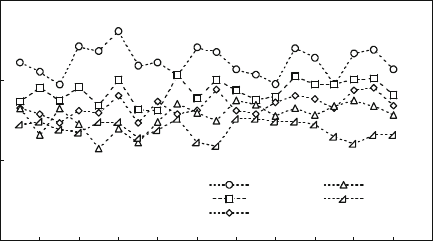
roughness for each abrasive belt under different cuts using the conditions in
Table 8.3. Though the removal rate is kept unchanged for the first three cuts, but
the surface roughness decreases with the increased cutting times.
8.2.1.5 Process Optimization and Quality Assurance
The selection of suitable abrasive belt for fine polishing of vane airfoil is critical for
achieving the required surface finish. The mesh size for polishing is supposed to be
finer than that for rough grinding in order to obtain shallower scratching marks.
In manual operation, fine polishing is conducted using a “scotch” belt, which uses
very fine abrasives and a different bond structure from the belt for rough polishing.
The “scotch” belt is much more expensive than the abrasive belt used for rough
polishing. Moreover, the use of different belts in fine and rough polishing processes
adds difficulty for tooling management in automation systems.
As shown in Fig. 8.12 , the SEM topographies of the used belts have indicated that
after polished three vanes, the sharp edges of abrasive grains are worn. The cutting
edges become dull and not suitable for material removal in rough polishing. Also
indicated in Fig. 8.13, the roughness values are below 1.6 mm (which meets the final
roughness requirement of the polished vane airfoils), when the belt is used to polish
the fourth and fifth vanes. Therefore, the belt disposed after rough polishing can be
re-used for fine polishing. To make sure that the surface roughness is below 1.6 mm, a
small pre-load with soft springs is applied for fine polishing in contrast to the use of a
large pre-load for rough grinding. The belt replacement plan in the robotic system
for vanes is that both abrasiv e belts for rough and fine polishing are replaced after
machined three vanes. The used belt in rough polishing is then re-used for fine
polishing. The idea using used belts for polishing is of great significance because the
production cost is reduced and the tool management is conven ient.
0
1
2
3
0 4 8 12 16 20
1st cut
2nd cut
3rd cut
4th cut
5th cut
Roughness, R
a
(mm)
Part Order No.
Fig. 8.13 Effect of polishing pass (or cut) of an abrasive belt on surface roughness of vane
airfoils. A new belt is used for each vane
8 Polishing Using Flexible Abrasive Tools and Loose Abrasives 357
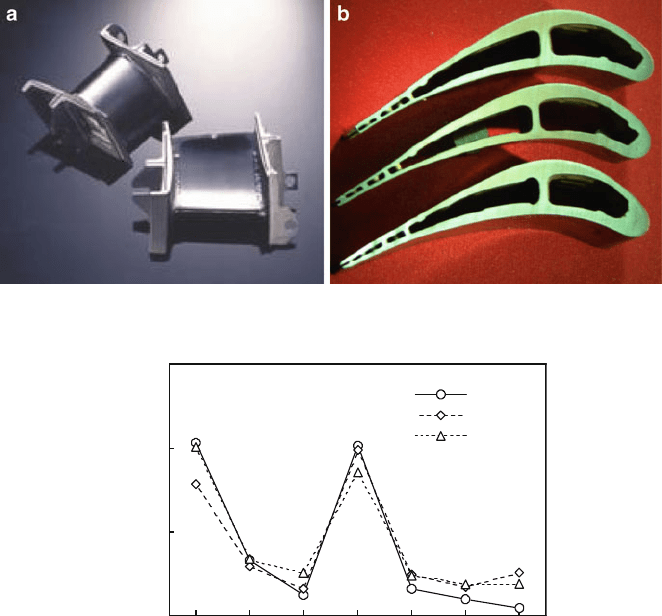
In the robotic machining system for 3D vane airfoils, various process optimization
strategies are used. For example, different machining plans are associated with
different tool path sections by varying belt speed, feed rate and approaching angle.
Repeated tool paths are also used to remove the local transition boundaries between
the brazed layers and vane base. This enables visually smooth airfoils to be achieved,
as shown in Fig. 8.14a. Except the surface finish, the dimensional accuracy of airfoil
wall thickness is examined by sectioning the airfoil, as shown in Fig. 8.14b, where
satisfactory profiles are demonstrated. The wall thickness of the polished airfoils
must also meet the requirement. As shown in Fig. 8.3b, seven locations are selected to
examine the minimum wall thickness. Figure 8.15 shows the relative thickness values
for the polished airfoils. Here the relative thickness is defined as the subtraction of the
nominal wall thickness from the measured wall thickness of a repaired airfoil. The
three machined parts are all within the tolerance values, as the relative thickness
values are positive.
Fig. 8.14 (a) Polished turbine vanes [19] and (b) sectioned pieces of vane airfoils
0
1
2
3
1234567
Part A
Part B
Part C
Relative Thickness (mm)
Check Point
Fig. 8.15 Relative wall thickness of polished airfoil at defined checking points
358 H. Huang et al.
8.2.2 Polishing of Fibre Optic end Faces Using Abrasive Films
Fibre optic connectors consist of a ferrule of diameter of 2.5 mm with a glass fibre
of 125 mm in diameter centered in the ferrule [21]. When assembling the fibre into
the ferrule, it exits at the ferrule’s end face. The end face thus needs to be polished
to achieve a smooth surface [22]. Ferrules are often made of ceramics, such as
zirconia. In the current production line manual polishing is required to remove the
excess fibre and epoxy bead first and several stages of machine polishing are then
followed [23]. After polishing, optical inspection, such as insertion and return loss,
are conducted to examine the optical quality of the polished connectors.
The commonly encountered problem in the production line is the difficulty for
maintaining flush of fibre and ferrule heights after polishing [24, 25]. Several extra
polishing procedures are needed to meet the require d relat ive heig ht between fibre
and ferrule faces, and thus the machining cycle time is long. In recent years, a great
effort [26–33] has been directed towards developing high efficiency grinding and
polishing processes for fiber connectors to meet the increasingly high demand from
optic communication industries. In this section, we report the effect of polishing on
the surface integrity and geometric measures of connector end faces, including
surface roughness, fiber height or undercut, apex offset and radius of curvature.
The relationships between geometrical parameters and optical quality, in terms of
return and insertion losses, are discussed.
8.2.2.1 Fibre Optic Connector and Polishing Set-Up
Fibre optic connectors being studied consist of a glass fiber of 125 mm in diameter
and a ferrule housing of 2.5 mm in diameter. The fibre is centered in the ferrule
and exited from its end face. The ferrule is made of yttria partially stabilized
zirconia. The ferrule is keyed in a mechanical assembly to align and hold the
fibre rigidly. The end face of connectors is convex, spherically curved with a radius
of curvature of about 20 mm. The protruded fiber end needs to be cleaved and the
epoxies are removed by manual polishing prior to machine polishing.
The functionality of fibre optic connectors is to coupl e two fiber cables for optic
communication. Thus, the geometric quality of fibre connectors will directly affect
the quality of light transmission, including the reflection loss caused by the rough-
ness of fiber end faces, the fiber separation, the lateral misalignment, the angular
misalignment, the core and cladding diameter mismatch, the refractive index profile
difference, and the contamination on fibre end faces. The geometrical parameters
include fiber and ferrule surface roughness of R
a
(arithmetic mean value), fiber
height or undercut, apex offset and radius curvature. “Fibre height” and “fibre
undercut” are defined to characterize the relative distances between the fiber end
face and the best fit of spherical surface of the average ferrule end face [22].
The fiber undercut refers to the situation where a fiber is positioned inside a ferrule,
while the fiber height indicates that the fibre protrudes above a ferrule. “Radius of
8 Polishing Using Flexible Abrasive Tools and Loose Abrasives 359
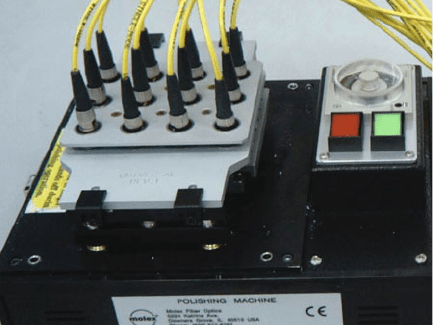
curvature” is the radius of best fit of a spherical ferrule end face and “apex offset” is
the linear distance from the center of a fiber to the apex or highest point on the best
fit of its spherical end face [ 22]. Geometrical quality for the polished connector end
faces was evaluated using an automated noncontact interferometer system for
array-type fiber-optic connectors (AC-3005, Norland).
A poli shing machine (8671X-6100 Series, Molex) was used for finishing the
fibre connectors. The machine, as shown in Fig. 8.16, has a timer and a pressurized
holder. The universal holder can contain 12 connectors. The machine provides a
circular orbital oscillation for polishing. During polishing, individual connec tor
rotates along its own circular orbit of 17.5 mm in diameter at a speed of 15 rpm,
while polishing media rotates at a speed of 285 rpm.
8.2.2.2 Effects of Abrasive and Polishing Protocol
The polishing of fibre connectors includes rough and fine processes. Disposable and
self-adhesive films were used for polishing. SiC films (see Fig. 8.17a) of grit sizes
of 5 and 3 mm were used in rough polishing for material removal. The films were
put onto an air-cushion metal pad with 12 circle orbits. Diamond (see Fig. 8.17b)
or alumina films of grit sizes of 0.5, 0.1 and 0.05 mm were used in fine polishing,
which were laid on a flat metal pad. Lubricants were sprayed on the abrasive films
during polishing.
Fig. 8.18 shows the optical images of the fiber end faces taken prior to and after
polishing with propylene glycol diamond suspension of grit siz e of 50 nm.
Figure 8.18a is the typical surface for a cleaved and epoxy-removed fiber connector
end face. Figure 8.18b shows the surface of a connector polished using a 5 mm SiC
film, where polishing marks, scratches and chippings are observed. Almost all the
damages occurred on the fibre material, i.e. fused silica of lower hardness and
Fig. 8.16 The machine for polishing optic fibre connectors
360 H. Huang et al.
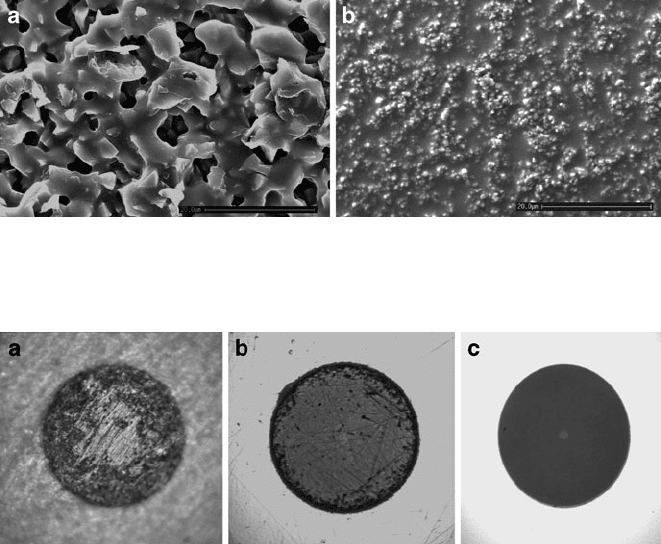
toughness than zirconia, include chipping and deep scratches. In contrast, only very
shallow scratches are observed on the ferrule surface, which has higher toughness
and hardness then silica. The polishing-induced damage using a 3 mm SiC film is
less severe than that using a 5 mm SiC film, as expected. Figure 8.18c is the second-
step polished end face using a 0.1 mm diamond film. No visible scratches and
damage are observed. Polishi ng with fine diamond abrasives also produc ed better
fibre height. As shown in Fig. 8.19, the fibre height of 53 nm left after polishing
using the fine diamond film is much smaller than the height of ~2 mm produced by
the 5 mm SiC film.
Combinations using different abrasives with different grit sizes for rough and
fine polishing were tested. The polishing step had the same cycle time of 30 s. The
polishing protocols shown in Table 8.4 consists of a rough polishing procedure
using coarse SiC films, aiming to remove the protruded fiber height after cleaving
and epoxy removal with high efficiency, and one or two fine polishing procedures
with diamond or alumina abrasives, aimi ng to obtain good surface finish. Six
connectors were simultaneously polished to examine the repeatability of the results.
Each protocol shown in Table 8.4 can produce satisfactory surface quality. It is
found that by judicious selection of abrasive types and grit sizes used for the rough
Fig. 8.17 SEM micrographs of polishing films for fibre end faces. (a) SiC abrasive film for rough
polishing and (b) diamond film for fine polishing
Fig. 8.18 Fibre end faces. (a) As-received, (b) polished for 30 s using 5 mm SiC film, and
(c) further polished for 30 s using 0.1 mm diamond film
8 Polishing Using Flexible Abrasive Tools and Loose Abrasives 361
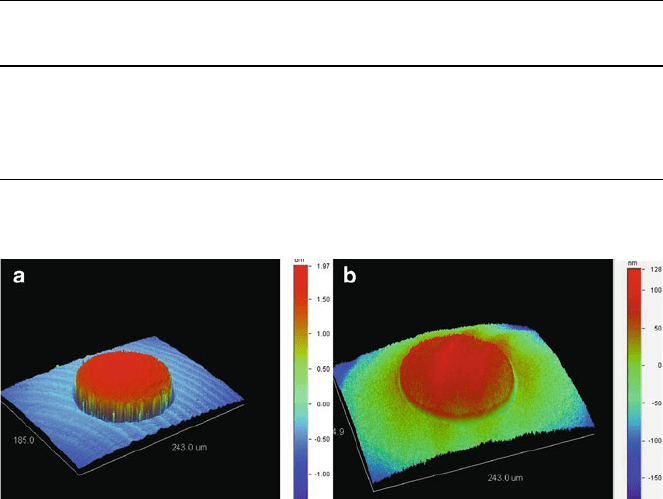
and fine polishing, the two-step polishing protocols (i.e. A2, B2 and C2) with a total
circle time of 60 s can produce satisfact ory outcome, which normally needs a three-
step polishing (i.e. A3 and B3) with a circle time of 90 s, in terms of ferrule surface
roughness, fiber height/undercut, radius of curvature and apex offsets.
8.2.2.3 Effect of Suspensio ns on Surface Quality and Optic Performance
Five lubricants containing different suspensions were used. Table 8.5 summarizes
the details of lubricants used. Sign “A” stands for 91% volume isopropyl alcohol.
Sign “B” refers to a suspension with colloidal silica of 50 nm. Sign “C” and “D”
represent propylene glycol and water-based diamond suspensions with particle size
of 50 nm, respectively. Sigh “E” is a water-based alumina suspension of particle
size of 50 nm.
The effect of different suspensions on the surface roughness of fibre connectors
is shown in Fig. 8.20. The colloidal silicon suspension (“B”) produced the smooth-
est surfaces for both fiber and ferrule. The surface roughness values of fiber
polished using alcohol and water-based alumina suspensions are almost the same.
However, the fiber roughness values using both propyl ene glycol- and water-based
Fig. 8.19 3D optical interference images showing the fibre heights after polishing using (a)5mm
SiC film, and (b) 0.1 mm diamond film [29]
Table 8.4 Parameters for rough and fine polishing processes
Process
Step 1 Step 2 Step 3
Film on air cushion
metal pad (30 s)
Film on flat metal
pad (30 s)
Film on flat rubber
pad (30 s)
Polishing
quality
A3 3 mm SiC 0.5 mm alumina 0.05 mm alumina Satisfactory
B3 3 mm SiC 0.1 mm diamond 0.05 mm alumina Satisfactory
A2 5 mm SiC 0.1 mm diamond Satisfactory
B2 5 mm SiC 0.1 mm diamond Satisfactory
C2 3 mm SiC 0.5 mm diamond Satisfactory
362 H. Huang et al.

diamond suspensions (“C” and “D”) are considerably higher, two time s that of the
silica suspension and one third those of the alcohol and alumina suspensions. The
surface roughness values of ferrule using alcohol, propylene glycol diamond
suspension and alumina suspensions are at the same level. The ferrule roughness
for the water-based diamond suspension is two times greater than that using the
silica suspension and about one third greater than that using alcohol or propylene
glycol diamond or alumina suspension.
Figure 8.21 shows the effect of suspension type used on the fiber height of
connectors. The fiber height resulted from using silica suspension is the smallest.
In contrast, the fiber heights for water-based diamond and alumina suspensions are
more than two times higher than that with silica suspension and 20–30% higher
than those with alcohol and propyl ene glycol diamond suspensions.
Figure 8.22 demonstrates the effect of suspe nsion on the radius of curvature. The
curvature of fibre end faces polished using alcohol is convex curve d, whose radius
is smaller than that using silica suspension. Polishing using propylene glycol-,
water-based diamond and alumina suspensions generated concave end faces, with
negative radii of curvature.
Table 8.5 Polishing
suspensions [32]
Suspension Description
A Isopropyl alcohol (91 vol.%)
B Colloidal silica suspension of grit size of 50 nm
C Propylene glycol diamond suspension of grit size
of 50 nm
D Water-based diamond suspension of grit size
of 50 nm
E Water-based alumina suspension of grit size
of 50 nm
0
5
10
15
20
Fibre
Ferrule
Roughness, R
a
(nm)
Suspension Type
ABCDE
Fig. 8.20 Effect of
suspension on surface
roughness of fibre and ferrule
8 Polishing Using Flexible Abrasive Tools and Loose Abrasives 363
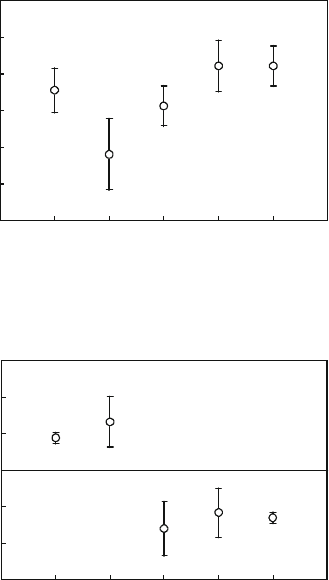
Values of apex offset of the fibre connectors polished using the five suspensions
are shown in Fig. 8.23. The alcohol generated the smallest apex offset. The silica
suspension gave a slightly larger apex offset than that of the alcohol, whereas the
propylene glycol diamond and alumina suspensions gave the largest offsets.
The water-based diamond suspension produced a higher offset than the alcohol
and the silica suspension but lower than the propylene glycol diamond and alumina
suspensions.
After polishing, the connector end faces must be carefully cleaned with alcohol
and optical tissues for optical performance testing. Optical performance for each
suspension is plotted in Fig. 8.24. The minimal value of return loss required for
acceptable physical contact transmission is 45 dB. The return losses for alcohol and
silica suspension are both better than 45 dB. However, the return losses for propyl-
ene glycol and water-based diamond suspe nsions are lower than 45 dB. The return
loss for alumina suspension just meets the requirement. The required insertion loss
for a fibre connector is 0.3 dB or below. Silica suspension produced a minimum
0
20
40
60
80
100
120
ABCDE
Fibre Height (nm)
Suspension Type
Fig. 8.21 Effect of
suspension on fibre height
-150
-100
-50
0
50
100
150
Radius of Curvature (mm)
Suspension Type
ABCDE
Fig. 8.22 Effect of
suspension on the radius of
curvature of polished
end faces
364 H. Huang et al.
